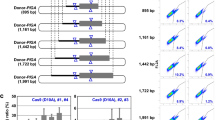Abstract
Using engineered nucleases such as zinc-finger nucleases (ZFNs) and TALE nuclease (TALEN) to accomplish genome editing often causes high cellular toxicity because of the consistent expression of artificial nucleases and off-targeting effect. And lacking selection marker in modified cells makes it hard to enrich these positive cells. Here we introduce a method by incorporating a surrogate reporter enrichment into a suicidal ZFN system, which is designed by a pair of ZFN expression cassettes flanked with its target sites. Our data demonstrated that this modified system achieved almost the same ZFN activity as the original method but reduced ~40% toxicity. This new suicidal ZFN expression system coupled with a surrogate reporter not only enables decreased cellular toxicity but also makes the genetic modified cells to be enriched by EGFP analysis.
Access this chapter
Tax calculation will be finalised at checkout
Purchases are for personal use only
Similar content being viewed by others
References
Lieber MR (2010) The mechanism of double-strand DNA break repair by the nonhomologous DNA end-joining pathway. Annu Rev Biochem 79:181–211
Lombardo A, Genovese P, Beausejour CM, Colleoni S, Lee YL, Kim KA et al (2007) Gene editing in human stem cells using zinc finger nucleases and integrase-defective lentiviral vector delivery. Nat Biotechnol 25:1298–1306
Pruett-Miller SM, Connelly JP, Maeder ML, Joung JK, Porteus MH (2008) Comparison of zinc finger nucleases for use in gene targeting in mammalian cells. Mol Ther 16:707–717
Kim H, Um E, Cho SR, Jung S, Kim H, Kim JS (2011) Surrogate reporters for enrichment of cells with nuclease-induced mutations. Nat Methods 8:941–943
Zhang C, Wang L, Ren G, Li Z, Ren C, Zhang T et al (2014) Targeted disruption of the sheep MSTN gene by engineered zinc-finger nucleases. Mol Biol Rep 41:209–215
Cornu TI, Cathomen T (2010) Quantification of zinc finger nuclease-associated toxicity. Methods Mol Biol 649:237–245
Acknowledgments
The authors thank the colleagues in Professor Zhang’s lab for their technical assistance and helpful collaboration. We are grateful to financial support from China’s Ministry of Agriculture (948 Program 2013-Z27), China’s Ministry of Science and Technology (National Science and Technology Major Project 2014ZX0801009B and 973 Program 2011CBA01002), and National Natural Science Foundation of China (NSFC 31172186).
Author information
Authors and Affiliations
Corresponding author
Editor information
Editors and Affiliations
Rights and permissions
Copyright information
© 2018 Springer Science+Business Media, LLC, part of Springer Nature
About this protocol
Cite this protocol
Xing, J. et al. (2018). An Improved Genome Engineering Method Using Surrogate Reporter-Coupled Suicidal ZFNs. In: Liu, J. (eds) Zinc Finger Proteins. Methods in Molecular Biology, vol 1867. Humana Press, New York, NY. https://doi.org/10.1007/978-1-4939-8799-3_13
Download citation
DOI: https://doi.org/10.1007/978-1-4939-8799-3_13
Published:
Publisher Name: Humana Press, New York, NY
Print ISBN: 978-1-4939-8798-6
Online ISBN: 978-1-4939-8799-3
eBook Packages: Springer Protocols




